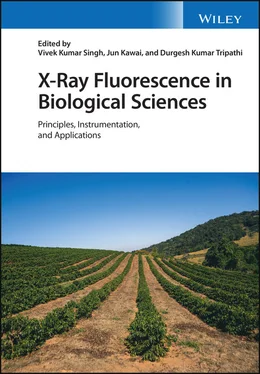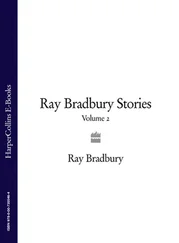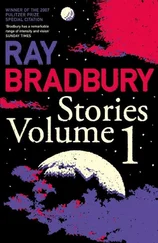X-Ray Fluorescence in Biological Sciences
Здесь есть возможность читать онлайн «X-Ray Fluorescence in Biological Sciences» — ознакомительный отрывок электронной книги совершенно бесплатно, а после прочтения отрывка купить полную версию. В некоторых случаях можно слушать аудио, скачать через торрент в формате fb2 и присутствует краткое содержание. Жанр: unrecognised, на английском языке. Описание произведения, (предисловие) а так же отзывы посетителей доступны на портале библиотеки ЛибКат.
- Название:X-Ray Fluorescence in Biological Sciences
- Автор:
- Жанр:
- Год:неизвестен
- ISBN:нет данных
- Рейтинг книги:5 / 5. Голосов: 1
-
Избранное:Добавить в избранное
- Отзывы:
-
Ваша оценка:
- 100
- 1
- 2
- 3
- 4
- 5
X-Ray Fluorescence in Biological Sciences: краткое содержание, описание и аннотация
Предлагаем к чтению аннотацию, описание, краткое содержание или предисловие (зависит от того, что написал сам автор книги «X-Ray Fluorescence in Biological Sciences»). Если вы не нашли необходимую информацию о книге — напишите в комментариях, мы постараемся отыскать её.
Discover a comprehensive exploration of X-ray fluorescence in chemical biology and the clinical and plant sciences X-Ray Fluorescence in Biological Sciences: Principles, Instrumentation, and Applications
X-Ray Fluorescence in Biological Sciences: Principles, Instrumentation, and Applications
X-Ray Fluorescence in Biological Sciences — читать онлайн ознакомительный отрывок
Ниже представлен текст книги, разбитый по страницам. Система сохранения места последней прочитанной страницы, позволяет с удобством читать онлайн бесплатно книгу «X-Ray Fluorescence in Biological Sciences», без необходимости каждый раз заново искать на чём Вы остановились. Поставьте закладку, и сможете в любой момент перейти на страницу, на которой закончили чтение.
Интервал:
Закладка:
Our estimates showed that for analytical lines from Na Kα to Cl Kα, the I relvalues were close to the I relvalues for Si Kα. The weak dependence of I relon the chemical composition of the samples used in this case (0.996–1.041, see Table 3.6) confirms the possibility of using an external standard method to calculate concentrations. For Kα lines in the wavelength range Ni Kα to Sr Kα I relwere close to the I relvalues for coherently scattered radiation of the Rh Kα ‐line. It follows from the obtained data that with the same contents of the analyzing elements the relative intensities of analytical lines from Fe Kα to Sr Kα can differ by 2.2–2.5 times (for K Kα in 1.34, for Ca Kα in 1.86 and for Ti Kα in 1.97 times). It is obvious that for elements with Z from 20Ca to 38Sr the proximity of the values I relto similar values for coherently scattered radiation of the Rh Kα‐line allows one to significantly improve accuracy of the analysis when using a method of the standard of a background. It should be noted that in publications of recent years have in some examples used the method of fundamental parameters. This method is included in most software modern X‐ray spectrometers, both large spectrometers and portable. In its application, it is important to ensure the homogeneity of the material of the samples to be analyzed. This problem is relatively easy to solve for coffee samples and more difficult for tea leaves.
3.8 Conclusion
The review showed that in recent years the XRF method has been frequently used to identify both basic and trace elements in tea and coffee, as it has some advantages over traditional analytical methods, which use pre‐treatment of sample material for analysis, which can contribute significantly to the total measurement error. The result of the determination is influenced by the utensils used to grind and prepare the material, water and brew time, and the chosen drying method. The chemical composition of the analyzed samples depends on the degree of fermentation, the grade of the material, the time of harvest, and the chemical composition of the soil in which the plant grew. It is worth noting that the limited set of standard samples makes it difficult to obtain accurate results, so additional analytical methods are desirable to monitor the accuracy of the determination results. Researchers, who used X‐ray spectrometers of different types, showed prospects for using XRF for this purpose. When analyzing the products in question with XRF, various methods were used to convert experimental intensities into the content of the elements to be determined: an external standard; background standard and fundamental parameters. Estimates of interelement effects on the intensity of analytical lines for tea, coffee and some plants are presented.
Tea leaves and coffee grains contain most of the elements necessary for human health. Researchers will have to do a lot of work to assess the contents of various elements in certain varieties of tea and coffee, to identify the dependence of their chemical composition on the influence of natural factors and to understand the mechanisms of influence on certain factors of human life.
References
1 1 Smichowski, P. and Londonio, A. (2018). The role of analytical techniques in the determination of metals and metalloids in dietary supplements: a review. Microchem. J. 136: 113–120.
2 2 Revenko, A.G. (2014). X‐ray fluorescence analysis of food products: its present and future [abstract]. In: Eur. Conf. on X‐Ray Spectrom., 82. Bologna, Italy.
3 3 Taylor, A., Barlow, N., Day, M.P. et al. (2019). Atomic spectrometry update: review of advances in the analysis of clinical and biological materials, foods and beverages. J. Anal. At. Spectrom 34 (3): 426–459.
4 4 Taylor, A., Catchpole, A., Day, M.P. et al. (2020). Atomic spectrometry update: review of advances in the analysis of clinical and biological materials, foods and beverages. J. Anal. At. Spectrom 35 (3): 426–454.
5 5 Revenko, A.G. (2000). X‐ray fluorescence analysis of biological samples. Ann. IB Komi SC UB RAS 28 (2): 14–16. (in Russian).
6 6 Revenko, A.G. (2013). X‐Ray fluorescence analysis of biological samples. In: Proceedings of 5th International Conference on Contemporary Physics, 175–197. Ulaanbaatar: University Press.
7 7 Revenko, A.G. and Khudonogova, E.V. (2014). X‐ray fluorescence analysis of food. In: Proc. 8th All‐Russian Conf. on XRF, 107. Russia: Irkutsk (in Russian).
8 8 Sharangi, A.B. (2009). Medicinal and therapeutic potentialities of tea (Camellia sinensis L.) – a review. Food Res. Int. 42: 529–535.
9 9 Iashin, I.I. and Iashin, А.I. (2010). The Chemical Composition of Tea and its Effect in Human Health. Moscow: TransLit Publishing (in Russian).
10 10 Toci, A.T., de Moura Ribeiro, M.V., de Toledo, P.R.A.B. et al. (2018). Fingerprint and authenticity roasted coffees by 1H‐NMR: the Brazilian coffee case. Food Sci. Biotechnol. 27: 19–26.
11 11 Haswell, S.J. and Walmsley, A.D. (1998). Multivariate data visualisation methods based on multi‐elemental analysis of wines and coffees using total reflection X‐ray fluorescence analysis. J. Anal. At. Spectrom 13: 131–134.
12 12 De La Calle, I., Costas, M., Cabaleiro, N. et al. (2013). Fast method for multielemental analysis of plants and discrimination according to the anatomical part by total reflection X‐ray fluorescence spectrometry. Food Chem. 138: 234–241.
13 13 Borgese, L., Bilo, F., Dalipi, R. et al. (2015). Total reflection X‐ray fluorescence as a tool for food screening. Spectrochim. Acta Part B 113 (1): 1–15.
14 14 Pashkova, G.V. and Revenko, A.G. (2015). A review of application of total reflection X‐ray fluorescence spectrometry to water analysis. Appl. Spectrosc. Rev. 50 (6): 443–473.
15 15 Revenko, A.G. and Sharykina, D.S. (2019). The application of X‐ray fluorescence analysis to research the chemical compositions of tea and coffee samples. Anal. Control 23 (1): 6–23. (in Russian).
16 16 Maltsev, A.S., von Bohlen, A., Yusupov, R.A., and Bakhteev, S.A. (2019). Evaluation of analytical capabilities of total reflection X‐ray fluorescence spectrometry for the analysis of drinks with sucrose matrix. Anal. Control 23 (4): 483–493.
17 17 Pashkova, G.V. (2009). X‐ray fluorescence determination of element contents in milk and dairy products. Food Anal. Methods 2: 303–310.
18 18 Pashkova, G.V., Smagunova, A.N., and Finkelshtein, A.L. (2018). X‐ray fluorescence analysis of milk and dairy products: a review. Tr. Anal. Chem. 106: 183–189.
19 19 McLeod, R.J., Garland, M., Hale, R.V. et al. (2013). Determining the most effective combination of chemical parameters for differentiating the geographic origin of food products: an example using coffee beans. J. Food Chem. Nutr. 01 (02): 49–61.
20 20 Marcos, A., Fisher, A., Rea, G., and Hill, S.J. (1998). Preliminary study using trace element concentrations and a chemometrics approach to determine the geographical origin of tea. J. Anal. At. Spectrom 13 (6): 521–525.
21 21 Fernández‐Cáceres, P.L., Martín, M.J., Pablos, F., and González, A.G. (2001). Differentiation of tea (Camellia sinensis) varieties and their geographical origin according to their metal content. J. Agric. Food Chem. 49 (10): 4775–4779.
22 22 Haytowitz, D.B., Pehrsson, P.R., and Holden, J.M. (2002). The identification of key foods for food composition research. J. Food Compos. Anal. 15 (2): 183–194.
23 23 Gonzalvez, A., Armenta, S., and De La Guardia, M. (2009). Trace‐element composition and stable‐isotope ratio for discrimination of foods with protected designation of origin. Tr. Anal. Chem. 28 (11): 1295–1311.
24 24 Armenta, S. and de la Guardia, M. (2016). Analytical approaches for the evaluation of food protected designation of origin. Eds. M. Espineira and F. Santaclara. In: Advances in Food Traceability Techniques and Technologies, 275–301. Woodhead Publishing.
Читать дальшеИнтервал:
Закладка:
Похожие книги на «X-Ray Fluorescence in Biological Sciences»
Представляем Вашему вниманию похожие книги на «X-Ray Fluorescence in Biological Sciences» списком для выбора. Мы отобрали схожую по названию и смыслу литературу в надежде предоставить читателям больше вариантов отыскать новые, интересные, ещё непрочитанные произведения.
Обсуждение, отзывы о книге «X-Ray Fluorescence in Biological Sciences» и просто собственные мнения читателей. Оставьте ваши комментарии, напишите, что Вы думаете о произведении, его смысле или главных героях. Укажите что конкретно понравилось, а что нет, и почему Вы так считаете.











